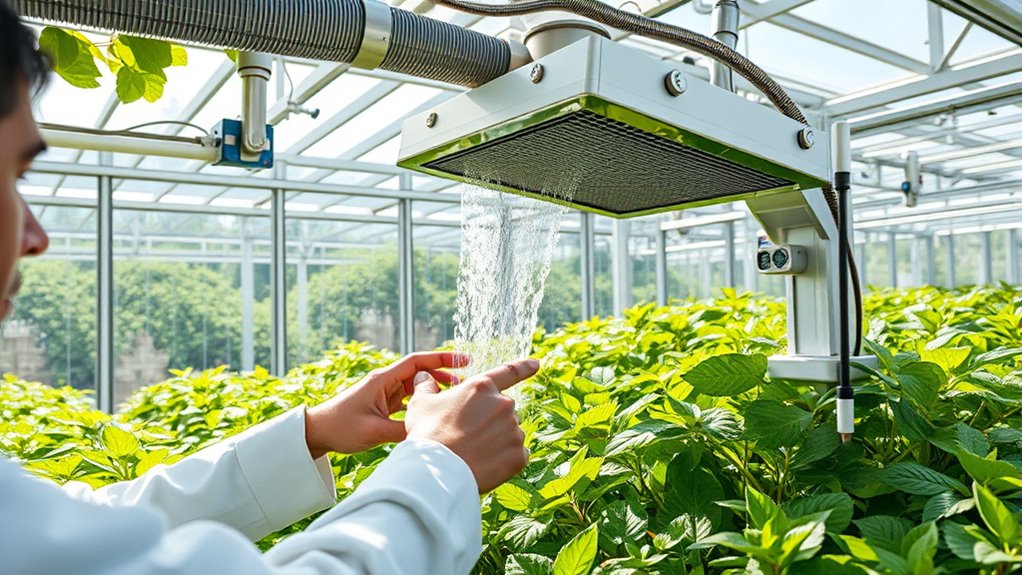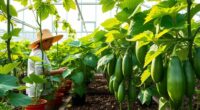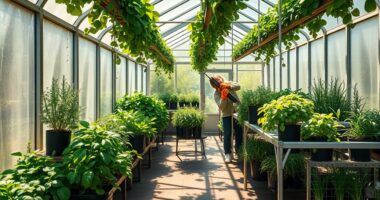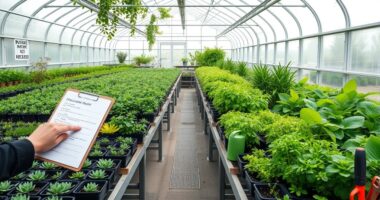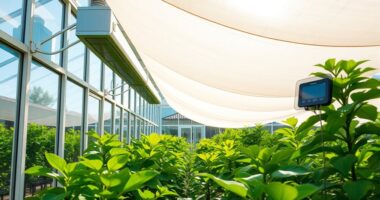Maintaining greenhouse ventilation systems is vital for optimal plant health. Start with regular inspections to catch issues early and keep everything running smoothly. Clean fan blades, check vents, and lubricate motors for efficiency. Consider upgrading to high-efficiency fans to lower energy costs. Automating the system can help you manage temperature and humidity more precisely. Seasonal checks are essential too, ensuring you're prepared for changing weather. Stick around to explore more about enhancing your greenhouse's performance.
Key Takeaways
- Conduct regular inspections to identify issues early and maintain optimal growing conditions in the greenhouse.
- Clean fan blades, lubricate motors, and check vents for efficient airflow and smooth operation.
- Replace old fans with high-efficiency models to significantly reduce energy consumption and improve performance.
- Automate ventilation systems with sensors and centralized controls for real-time adjustments and energy savings.
- Adjust ventilation rates seasonally to manage humidity and temperature effectively throughout the year.
Importance of Regular Inspections
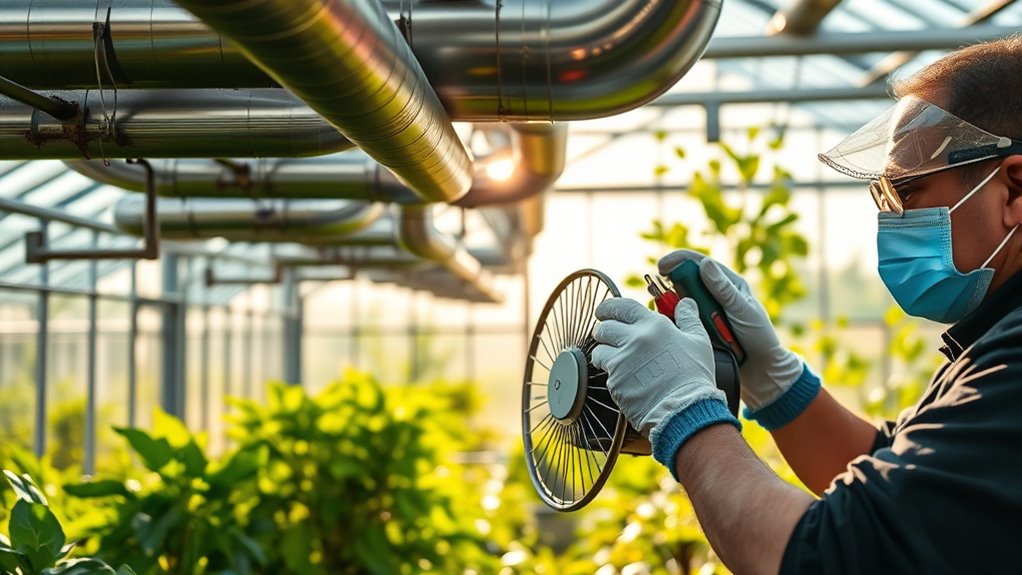
While you may think your greenhouse ventilation system is running smoothly, regular inspections are crucial to ensuring its long-term performance. These checks help you spot potential issues before they escalate into major failures, minimizing downtime and maintaining optimal growing conditions. By ensuring all components function correctly, you boost the system's efficiency and ultimately save money by preventing costly repairs. Regular inspections also maintain air quality by effectively removing stale air and pollutants, which supports healthy plant growth. Common issues like dust accumulation, obstructions, and worn-out parts can be swiftly addressed through routine inspections, ensuring your ventilation system operates at its best. Additionally, regular inspections can help regulate temperature, which is essential for optimal plant growth. Prioritizing these inspections is essential for the health of both your plants and your investment.
Essential Maintenance Tasks
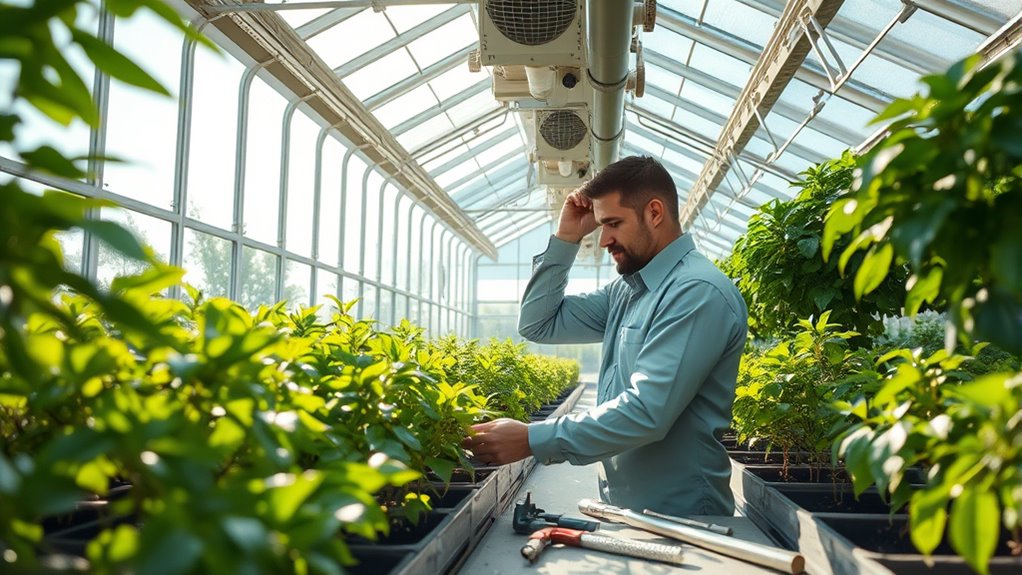
Regular inspections set the stage for effective maintenance tasks that keep your greenhouse ventilation system running smoothly.
Start with fan maintenance; clean blades and guards to ensure efficient airflow, and lubricate unsealed bearings. Check all vents, louvers, and fans regularly to confirm they're functioning properly.
Don't forget to lubricate motors and actuators to maintain smooth operation. Ensure all electrical components are serviced by qualified technicians for safety.
Verify the alignment of all components to optimize performance. Schedule routine cleaning of evaporative cooling pads and replace or clean filters to maintain airflow efficiency. Additionally, maintaining optimal humidity levels is essential to prevent plant diseases and support healthy growth.
Finally, perform calibration checks on temperature and humidity sensors, adjusting settings as seasons change for optimal plant growth. Regular attention to these tasks is crucial for success.
Energy Efficiency Considerations
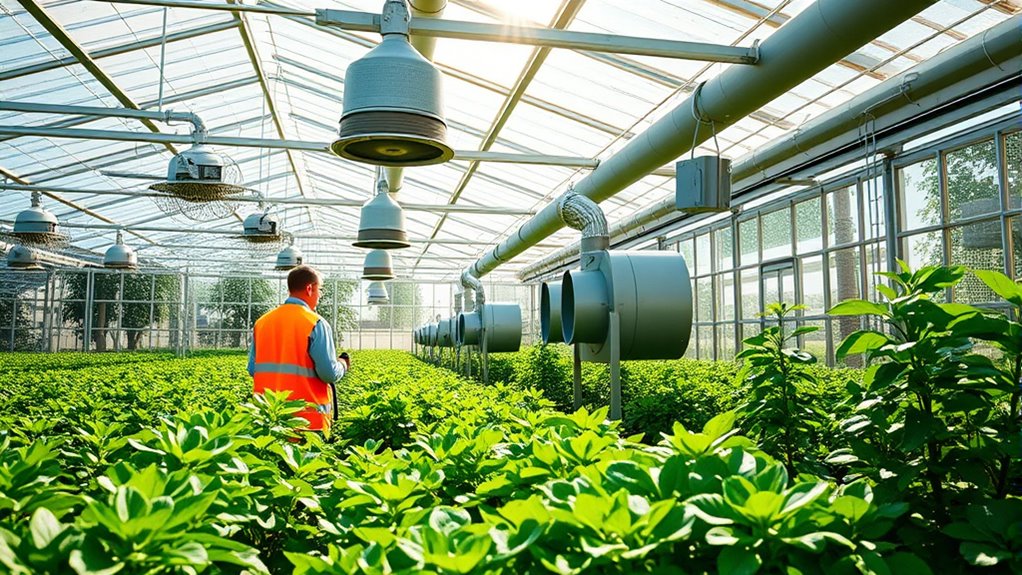
To maximize the performance of your greenhouse ventilation system, it's essential to focus on energy efficiency.
Start by replacing old fans with high-efficiency models to cut energy consumption significantly. Regular maintenance, like cleaning and lubricating fan components, can boost efficiency by up to 50%. Additionally, implementing energy conservation strategies can further enhance the overall performance of your greenhouse systems. Consider utilizing natural ventilation through strategically placed vents to lessen your reliance on mechanical systems. Check the ventilation efficiency ratio of your fans to ensure you're using the most efficient models.
Additionally, invest in insulation and seal any leaks to minimize heat loss, which enhances airflow control.
Automating Your Ventilation System

How can automating your greenhouse ventilation system transform your growing environment?
By integrating automated systems with climate control, you gain precise management of temperature and humidity. Using sensors, your system can monitor critical levels and adjust ventilation in real-time. Automation creates optimal growing conditions for crops by ensuring that external factors that can harm plant growth are mitigated.
With centralized control, you can easily manage everything from one interface, saving time and effort. Automated fan systems turn on and off based on thermostat settings, ensuring optimal airflow.
You can also enhance efficiency by utilizing motorized shutters and variable speed controllers. This eliminates guesswork, reduces energy costs, and boosts crop yields.
Ultimately, automation simplifies maintenance and creates a more consistent environment for your plants to thrive. Embrace technology to elevate your greenhouse's performance!
Addressing Humidity and Temperature Control
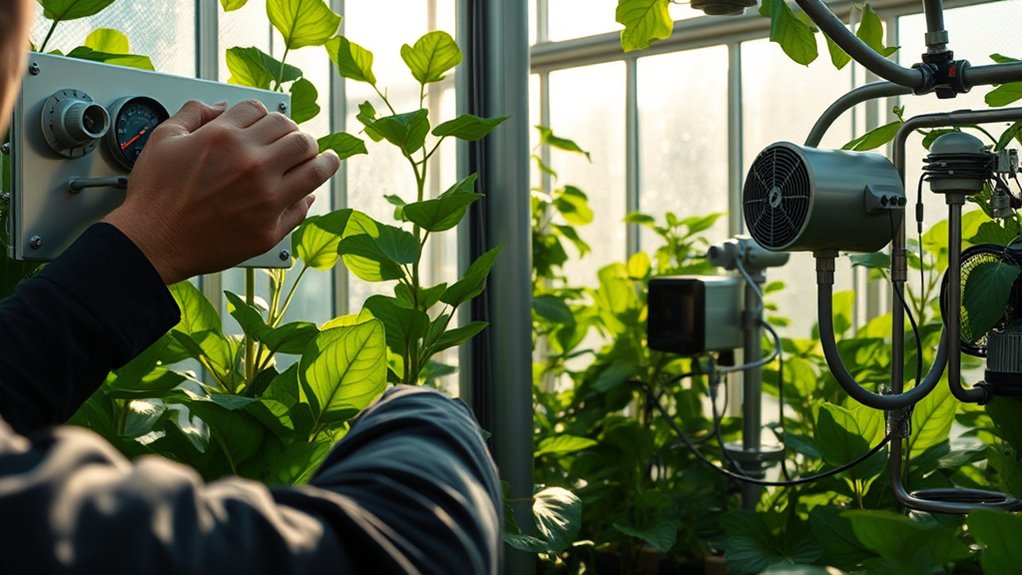
Automating your greenhouse ventilation system sets the stage for effective humidity and temperature control, two vital components of a thriving growing environment.
Maintaining around 80% humidity at 80°F (27°C) is ideal for most plants, but be wary of high humidity leading to diseases like powdery mildew. Use a humidistat to monitor levels closely.
To reduce humidity, ventilate by exchanging humid air with cooler outside air and implement drip irrigation to minimize evaporation.
For temperature management, keep your greenhouse between 64°F and 75°F (18-24°C). Use fans for cooling and radiant heating systems for consistent warmth.
Utilizing Advanced Technologies

As greenhouse technology evolves, utilizing advanced ventilation systems can significantly enhance your growing environment. Automation systems allow you to precisely control ventilation, temperature, and humidity with programmable settings and responsive sensors. This reduces manual adjustments, boosting efficiency and consistency in your greenhouse. You can also implement motorized ventilation systems, including shutter fans and motorized shutters, which operate automatically based on temperature, ensuring reliable airflow. Integrating climate control solutions enables real-time monitoring of critical factors like CO2 levels, helping you make informed decisions for optimal plant growth. Additionally, automation tools can enhance greenhouse management and efficiency, further supporting your efforts to maintain an ideal growing environment.
Seasonal Maintenance Practices

To ensure your greenhouse thrives year-round, it's vital to implement seasonal maintenance practices tailored to the unique demands of each season.
In winter, adjust ventilation rates to two to three air changes per hour to manage humidity while keeping heating costs low. Inspect and prepare your heaters during autumn to ensure efficiency and service heating equipment annually before the heating season with a licensed HVAC company.
As temperatures rise in spring and fall, monitor ventilation systems closely and adjust rates accordingly.
In summer, increase ventilation to one air change per minute and maintain your cooling systems, including cleaning evaporative cooling pads.
Don't forget to check for pests regularly.
Each seasonal adjustment keeps your greenhouse healthy, productive, and energy-efficient, ensuring your plants get the best care possible.
Frequently Asked Questions
How Often Should I Check My Ventilation System Components?
You should check your ventilation system components at least once a month.
Regular inspections keep everything functioning properly and can prevent costly repairs. Dusting off fan blades and cleaning components is crucial, as dust can seriously impact efficiency.
Don't forget to lubricate fan bearings and inspect electrical cords for any damage.
What Are the Signs of a Malfunctioning Ventilation System?
If your ventilation system's malfunctioning, you might notice signs like high humidity, foggy windows, or water pooling on surfaces.
You could also see overheating, with temperatures rising above 100°F, stressing your plants.
Stagnant air may lead to poor growth, increased pests, and diseases.
If you observe these issues, it's crucial to address them quickly to ensure your plants thrive and maintain a healthy environment.
Regular checks can prevent further problems.
Can I Install a Ventilation System Myself?
"Where there's a will, there's a way!" Yes, you can definitely install a ventilation system yourself.
With the right materials, planning, and a bit of effort, it's a feasible DIY project. Start by determining the type of ventilation you need and gather essential components like fans and vents.
Remember to consider placement for optimal airflow. As you work, don't hesitate to seek guidance online or from experienced friends to ensure a successful installation!
What Is the Lifespan of Ventilation System Components?
The lifespan of ventilation system components varies.
Generally, ventilation fans last several years with proper care, while evaporative cooling pads can last up to ten years.
You'll notice efficiency drops if dust builds up on fan blades or if cooling pads clog with algae.
Regular maintenance, like cleaning and inspection, is essential.
If you size your fans correctly and keep everything well-maintained, you can maximize the lifespan of your system components.
How Do Weather Conditions Affect Ventilation System Performance?
Imagine your ventilation system battling a hurricane! Weather conditions dramatically impact its performance.
On calm days, you'll enjoy efficient airflow, but when winds whip up, they can either boost or hinder ventilation. High temperatures might leave your system gasping for relief, while humidity can turn your greenhouse into a sauna.
You've gotta stay vigilant, adjusting for these conditions to ensure your plants thrive and your ventilation system doesn't throw in the towel.
Conclusion
As you stand in your greenhouse, the air feels stifling, and the plants seem to droop slightly. You realize that neglecting your ventilation system could mean disaster. But imagine transforming that stagnant air into a refreshing breeze, revitalizing your plants and ensuring their growth. By committing to regular inspections and embracing advanced technologies, you can create an environment that thrives. Don't wait for the tipping point—act now, and watch your greenhouse flourish like never before.
